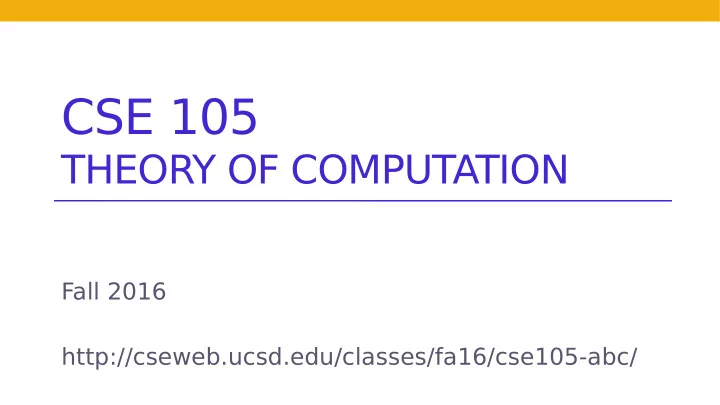

CSE 105 THEORY OF COMPUTATION Fall 2016 http://cseweb.ucsd.edu/classes/fa16/cse105-abc/
T oday's learning goals Sipser Ch 1.1 • Use and design a fjnite automaton via its - Formal defjnition - state diagram - haskell implementation • Identify the strings and languages accepted by a given fjnite automaton • Design a fjnite automaton which accepts a given language
Review: Finite automaton • Input: fjnite string over a fjxed alphabet • Output: "accept" or "reject" Start state Accept state (triangle/arrow) (double circle) Computation : sequence of states traversed by the machine Language of the machine is the set of strings it accepts
Finite automaton • Input: fjnite string over a fjxed alphabet • Output: "accept" or "reject" Does this DFA accept the string 10110 ? A. Yes B. No C. I don't know
Finite automaton • Input: fjnite string over a fjxed alphabet • Output: "accept" or "reject" Does this DFA accept the empty string ? A. Yes B. No C. I don't know
Finite automaton Sipser p. 35 Def 1.5 No circles and No circles and arrows, same arrows, same information! information!
Finite automaton Sipser p. 35 Def 1.5 Can there be more than one start state in a fjnite automaton? A. Yes, because of line 4. B. No, because of line 4. C. I don't know
Finite automaton Sipser p. 35 Def 1.5 Can there be zero many accept states ? A. Yes, in which case the language is empty. B. Yes, in which case the language is all strings. C. No, because of line 5. D. I don't know.
Finite automaton Sipser p. 35 Def 1.5 Can one state have two difgerent transitions labelled with the same symbol going out of it? A. Yes, because of 2. B. Yes, because of 3. C. No, because of 2. D. No, because of 3. E. I don't know.
Finite automaton Sipser p. 35 Def 1.5 How many outgoing arrows from each state? A. May be difgerent number at each state. B. Must be 2. C. Must be |Q|. D. Must be |Σ| E. I don't know.
Function computed by a DFA ● The mathematical defjnition (Q,Σ,δ,q 0 ,F) only capture the syntax of a DFA ● We also need to defjne how each DFA specifjes a function f M : Σ → {True,False} ● Helper function: δ * : QxΣ * → Q δ * (q,“”) = q – δ * (q,(aw)) = δ * (δ(q,a),w) [for any a in Σ and w in Σ * ] – Equivalent (but less effjcient) defjnition: δ * (q,(wa)) = δ(δ * (q,w),a) –
Implementing DFAs in Haskell
An example What's the best description of the language recognized by this DFA? A. Start with b and ends with a or b B. Starts with a and ends with a or b C. a's followed by b's D. More than one of the above and using set and using set notation? notation? E. I don't know.
An example This DFA recognizes the language of all strings of the form “a's followed by b's” i.e. { a n b k | n,k ≥ 1}
Another example What is the best description of language recognized by this automaton? A. { a n b k | n,k ≥ 1} B. { a n b k | n ≥ 1, b ≥ 0} C. { awb | w in {a,b}* } D. { aw | w in {a,b}* } E. I don't know
Regular languages Sipser p. 35 Def 1.5 • If A is the set of strings that DFA M recognizes (accepts) • We say A is the language of M • We write L(M) = A • We conclude that A is regular because… A language is regular if there is some fjnite automaton that recognizes exactly it.
Vocabulary review From CSE20, etc. See Chapter 0 • { a,b,c,d,e } The set whose elements are a,b,c,d,e • { a,b }* The set of fjnite strings over a,b • Includes empty string • Includes a, aa, aaa • Includes b, bb, bbb • Includes ab, ababab, aaaaaaabbb • Does not include infjnite sequences of a's and b's • Has infjnitely many difgerent elements • | ababab | = 6 The length of the string ababab is 6 • | { a,b,c,d,e } | = 5 The size of the set {a,b,c,d,e} is 5
Specifying an automaton ( {q1,q2,q3}, {a,b}, δ, q1, ? ) What's the best representation of δ for this DFA? A. q1→b, q1→a, q2→a, q2→b, q3→ a,b. B. { (q1,b,q1),(q1,a,q2),(q2,a,q2), (q2,b,q3),(q3,a,q3),(q3,b,q3)} C. δ(b) = same, δ(a) = change D. No description other than the state diagram (circles & arrows) is possible. E. I don't know.
Specifying an automaton ( {q1,q2,q3}, {a,b}, δ, q1, ? ) What state(s) should be in F so that the language of this machine is { w | ab is a substring of w}? A. {q2} B. {q3} C. {q1,q2} D. {q1,q3} E. I don't know.
Specifying an automaton ( {q1,q2,q3}, {a,b}, δ, q1, ? ) What state(s) should be in F so that the language of this machine is { w | b's never occur after a's in w}? A. {q2} B. {q3} C. {q1,q2} D. {q1,q3} E. I don't know.
T erminology: summary • Alphabet : nonempty fjnite set of symbols • String over an alphabet: fjnite sequence of symbols • Language over an alphabet: some set of strings • DFA over an alphabet: deterministic fjnite automaton • Input: fjnite string over a fjxed alphabet • Output: "accept" or "reject" • L(M) = {w | M accepts w} Start state Accept state • Regular language (triangle/arrow) (double circle) language that is L(M) for some DFA M
Next time • Homework 1 due Wednesday! • Set up course tools: Gradescope , Piazza, JFLAP, haskell • Complete the assignment and submit by 11:59pm • Closure Properties of Regular Languages • What languages are regular? • Can regular languages be combined together?
Recommend
More recommend